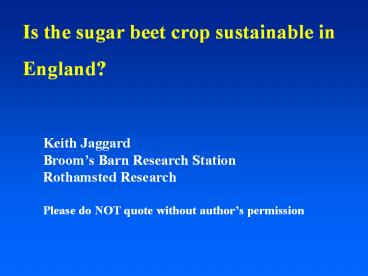Is the sugar beet crop sustainable in England? - PowerPoint PPT Presentation
Title:
Is the sugar beet crop sustainable in England?
Description:
Title: No Slide Title Author: IACR Brooms Barn Last modified by: School of Geography Created Date: 2/17/2001 4:02:19 PM Document presentation format – PowerPoint PPT presentation
Number of Views:73
Avg rating:3.0/5.0
Title: Is the sugar beet crop sustainable in England?
1
Is the sugar beet crop sustainable in England?
Keith Jaggard Brooms Barn Research
Station Rothamsted Research Please do NOT quote
without authors permission
2
Scope
- UK beet sugar industry
- Biodiversity pesticide impact
- Soil water
- Energy
- Economics
- Politics world trade
3
UK beet sugar industry
- Products are c. 1.3Mt sucrose, 0.8Mt dried
animal feed, 0.4Mt lime, 0.6Mt soil, betaine and
vinasse (a K fertilizer), electricity and heat
for glasshouses, - 6 factories
- 7,100 growers using 150,000 ha
- 20,000 jobs in sugar and supply industries
4
The distribution of beet crops in the UK, 2000
5
Bury beet sugar factory
6
The crop
- Sown March, harvested September January,
processed September to end February (c. 160 days) - Average yields c. 50t/ha beet at 17-19 sugar
content (9t/ha sucrose) - Grown on well drained soils, mostly in eastern
England - Typically c. 19 man hours/ha
7
Beet seed drill
8
(No Transcript)
9
(No Transcript)
10
(No Transcript)
11
Environment impact assessment
- Joint project with Hertfordshire University
assessed - impact fate of pesticides
- fate of N fertilizer
- energy consumption CO2 production
- global warming potential
- Used 13 crop production scenarios in 3 UK regions
- Used typical beet crop habitat
12
Scenario 1
Sandy soil, limed and dressed with organic
manure, ploughed and pressed in February, drilled
in March. Granular insecticide at drilling and
sprayed 4x to control weeds, once to control
diseases. Given 80kg N/ha, hoed once, irrigated
2x. Harvested December at 50t/ha.
Scenario 11
Peat soil, fertilized with P, K, Mg in October,
ploughed December, cultivated February and sown
with cover crop to control wind erosion. Sown
early April with insecticide-treated seed and
given 30kg N/ha. Sprayed 7x to kill weeds and
cover crop, 2 of these sprays contained Mn, one
B. Sprayed 1x with fungicide. Harvest 60t/ha mid
October.
13
Pesticide risk assessments made using pEMA
- p-EMA models dispersion pathways of pesticides in
the environment to estimate the concentrations to
which organisms will be exposed. These
concentrations, and their toxicity to the
organisms, are used to calculate risk indices.
This follows the procedures used in UK regulatory
assessments
14
Specific Risks
15
(No Transcript)
16
(No Transcript)
17
Frequency of environments adjacent to beet fields
18
Pesticides contributing most to risk
19
Average ecotoxicity score
Potatoes 230
Sugar beet 26 (67)
Winter wheat 35
Oilseed rape 85
Spring barley 30
Peas 75
20
Groundwater
- No significant risk to groundwater in any
Scenario - Lenacil was at most risk of leaching into
groundwater, but was still in the acceptable band
21
Fate of N fertilizer
- Nitrate leaching trivial 0.3-7kg/ha
- Denitrification large losses (6-56kgN/ha, mean
of 15kg/ha) associated with organic manures
(applied to 30 of beet area). - Important consequences of N2O production for
global warming.
22
Energy consumption
- Considered input manufacture, cultural
operations, transport and machinery manufacture - Input ranged from15-25 GJ/ha, with a mean of 20.4
at the factory gate - Output in delivered beet ranges from 150-220
GJ/ha - Output/input ratio 6-13
23
Energy consumption and GWP
Crop Input (GJ/ha) GWP (tCO2/ha)
Potatoes 31.3 3.0
Sugar beet 19.8 (20.4) 1.4
Winter wheat 20.8 1.7
Oilseed rape 15.5 1.2
Spring barley 9.3 0.7
Peas 6.7 0.7
24
Soil conservation
- Wind erosion was an expensive problem now mostly
controlled by cover crops or minimum tillage - Water erosion within field movement in 15 of
beet fields, where average redistribution is
0.3mm/ha, but this is concentrated in vulnerable
patches - Soil lost during beet delivery c. 2.7mm in 50
years, but this is recycled
25
Economics price structure
- Current beet price c. 30/t of quota
- Payments made for early and late delivery and an
allowance for delivery costs - Beet surplus to quota makes sugar which must be
exported outside the EC. Current value c. 5/t
26
Current profitability
- 13 beet production scenarios
- Assume 10 of beet is surplus
- Calculate net margins
- Range from 256/ha to 784/ha most variation due
to yield differences. Weighted average 560/ha - Real returns are less if proportion of surplus
beet is larger
27
Comparison of gross margins 2001 (/ha)
Winter wheat 550
Winter barley 435
Spring barley 412
Oilseed rape 448
Sugar beet 826
Potatoes 2672
- Includes area payment (200-250)
- Source Lang, 2002
28
Whole farm performance 2001 (/ha)
With beet Without beet
Output 558 401
Support pay 178 209
Var. costs 246 183
G. margin 490 427
Fixed costs 506 504
Net farm income 81 19
Source Lang, 2002
29
Politics and World Trade
- 2006 review EU Sugar Regime
- Regime sets national quotas
- Guarantees price for quota sugar
- 1.1Mt tariff-free sugar from ACP
- Surplus exported outside EU
- But
- EU quota more than consumption
- WTO unhappy
30
Review Options
- Consider impact on environment
- then
- Status quobut quota and price reduced
- Reduced quota perhaps SFP compensation quota
phased out - Free market first preference of Oxfam and
NGOs
31
(No Transcript)
32
Brazil
- World price c.10c/lb
- Production for export up from c. 1 to14 Mt since
1990 - Meanwhile Australian industry on its knees
33
Alternative uses
- Potential biofuel source
- Sugar is the simplest starting point for
bioethanol manufacture - Used for ETBE production in France
- Proven agriculture
- Potential to simplify and cheapen sugar
extraction in a mixed facility
34
Conclusions
- Sustainable ecologically and economically
- Endangered politically
- Possible use as biofuel































